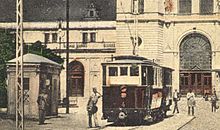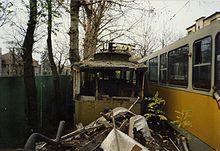Weitzer railcar of the Timișoara tram
| Weitzer railcar | |
|---|---|
|
Car number 8 in the delivery condition
|
|
| Number: | 17 railcars |
| Manufacturer: | János Weitzer wagon factory |
| Year of construction (s): | 1898-1899 |
| Retirement: | 1919-1921 |
| Gauge : | 1435 mm |
| Length over coupling: | 6705 mm |
| Length: | 6565 mm |
| Width: | 2000 mm |
| Fixed wheelbase: | 1680 mm |
| Traction power: | 20, after conversion 25 HP |
| Seats: | 18th |
| Standing room: | 12 |

The Weitzer railcars of the Timișoara tram were a series of trams - railcars of the Timișoara tram in Romania , which at the time of procurement still belonged to the Kingdom of Hungary . The manufacturer of the 17 standard-gauge vehicles was the János Weitzer wagon factory from nearby Arad , the electrical equipment was supplied by the electricity company Felix Singer & Co. from Berlin .
The Weitzer cars were the first generation of electric tram cars in Timișoara. The then Temesvári Villamos Városi Vasút Részvénytársaság (TVVV) procured them when they converted the horse-drawn tram, which had existed since 1869, to electrical operation on July 27, 1899.
description
The compartment of a Weitzer car was 4365 millimeters long and 2000 millimeters wide. The two open stages were each 1,100 millimeters long and 1,932 millimeters wide. The total length was 6565 millimeters, according to a second source it was even 6705 millimeters. The coaches had 18 seats on longitudinal benches and twelve standing places. The power was transmitted via a pantograph with a contact roller from the Dickinson system , and the single-engine wagons (Walker system) initially had 20 horsepower . Characteristic of the small four-window wagons were their short wheelbase of only 1680 millimeters and the lantern roof . The slightly protruding sheet metal cladding of the fittings was just as typical, which is why the three-part windshield was comparatively low.
commitment

The first ten Weitzer cars were built in 1898 and were therefore available for test drives in advance. The remainder were made in the first half of 1899. They mostly ran solo, but during rush hour they were also used with Spiering sidecars from 1869 , which were former horse-drawn trams , on the two main lines I and II . Up to 1906, 13 wagons were required for the scheduled operation of the initially five lines, i.e. four were available as a reserve.
Because the motorization proved to be too low in the long run, the company increased the engine power of all 17 cars by five to 25 horsepower in 1909. The fact that the Weitzer railcars, later also known as small cars , were too weak was particularly noticeable in a direct comparison with the twin-engine cars from the manufacturers Schlick and MWG used from 1906 - locally also known as large cars or from 1922 Type B. These also offered more passengers space. With the introduction of the larger cars on May 21, 1906, the sidecar operation in Timișoara also ended temporarily , so the Weitzer cars were only used solo from 1906. Although the company reintroduced trailers on Line I in 1909, there were sufficiently large cars available for this. Another change was the war-related replacement of the metal grilles in the entry areas with wooden ones.
With the last delivery of large wagons in 1915, the small Weitzer wagons were largely dispensed with in regular operation. Only a small part of the daily wagon departure still had to be served by them as planned, the others served as a reserve:
- according to statistics from December 31, 1915: 28 courses , 26 of them with large wagons and two with Weitzer wagons
- According to statistics from December 31, 1916: 28 courses, 26 of them with large wagons and two with Weitzer wagons
- According to statistics from December 31, 1917: 28 courses, 26 of them with large wagons and two with Weitzer wagons
- according to statistics from December 31, 1918: 26 courses, 26 of them with large cars
- According to statistics from December 31, 1919: 27 courses, 26 of them with large wagons and one with Weitzer wagons
- according to statistics from December 31, 1920: 26 courses, including 26 with large wagons
Conversion to sidecar or D-railcar
Because the weaker Weitzer cars in particular were exposed to heavy loads at the beginning of the First World War , they were badly worn out at the end of the war. To make matters worse, there were no electrical spare parts available in the immediate post-war period, especially considering the then uncertain political situation after the collapse of the Austro-Hungarian dual monarchy . The Tramvaiele Comunale Timișoara ( TCT ) now called Tramvaiele Comunale Timișoara ( TCT ) converted 14 of Weitzer cars into sidecars, which were then run as Type A and Type AII from 1922 :
- 1919: eight cars with unknown numbers (type A)
- 1920: four cars with unknown numbers (type A)
- 1921: Car 7 and 13 (type AII, completely reconstructed in the course of demotorization)
Cars 4 and 8, however, were converted into the two D railcars with the numbers 44 (formerly 8) and 46 (formerly 4) in 1921 - with continued use of the passenger cabin and the addition of new entry platforms. However, no further modifications were made because the company built the seven completely new DII cars that were copies of the D cars.
The 14 electrical equipment of the demotorized Weitzer railcars that had become free was also used. The company used them to equip all its own railcars until 1927, these were the seven DII cars (1922-1924), the self-propelled snow plow (1925) and the six F-cars (1925-1927).
Since car number 6 had also been used as a work car from 1919 at the latest , from 1921 not a single Weitzer multiple unit was available for passenger transport.
Remaining railcar number 6
In the first half of the 1920s, the work car with the number 6 was the only Weitzer multiple unit to have a more modern hoop pantograph instead of the original roller pantograph . It was used for repairs to the overhead line and for this purpose was mostly used together with the company's tower car . In the mid-1920s he received number 2, which had become vacant in 1923, with a second occupation.
Because there was a great shortage of sidecars at the end of the 1920s, the last Weitzer railcar was temporarily converted into a trailer for regular passenger traffic on March 21, 1927 - while maintaining the number 2. It was therefore temporarily also listed as Type A. As early as March 1, 1932, the tram company used it again as a motorized work car, although it completely lost its operating number and was henceforth used without a name. As part of the modernization program from 1956 to 1960, it was also fitted with a pantograph like all the other cars in the fleet at that time .
For the 70th anniversary of the electric tram in July 1969, the transport company prepared the work car as a museum car and presented it to the public with the inscription "1899 1969" on the side. From 1972 the vehicle - still without a company number - was assigned to the then opened depot number 2 in the Dâmbovița district as a shunting railcar. After Locomotive 1 took over this task from 1975 , the last Weitzer multiple unit was retired after 76 years of operation.
On the occasion of the 125th tram anniversary in 1994, it was finally demotorized again and converted into a historic horse-drawn tram. For this purpose, it received a new structure based on the model of the very first tram cars delivered to Timișoara from 1869.
Related series
The type of car discussed here only existed in Timisoara. Very similar wagons - that is, also single-engine and equipped with a Walker engine and Dickinson pantographs - could also be found in other companies equipped by the Felix Singer & Co. electricity company at the time:
- the initial equipment of the Bamberg tram , that is, the railcars 1–15 built by MAN in 1897 with an output of up to 25 hp
- the initial equipment of the Liegnitz tram , that is, the railcars 1–18 built in 1898
- the initial equipment of the Rijeka tram , that is, the railcars 1–8 built by Ganz in 1899 with an output of 17 hp
- the initial equipment of the Toruń tram electrified in 1899
- the initial equipment of the Stralsund tram , that is, the railcars 1–7 built in 1900 by Waggonbau Bautzen
In both Timișoara and Rijeka, the tram companies had to pay a fine because they purchased the engines from abroad. In addition, the sidecars of the Abbazianer Elektrizitäts- und Kleinbahn-Gesellschaft (AEK) opened in 1908 largely corresponded to the Weitzer railcars in Timișoara.
literature
- 60 de ani de la înființarea tramvaiului în Timișoara, monograph 1869-1929 . Timișoara 1929.
- Vasile Deheleanu, Sabin Indrieşu: Monografia întreprinderilor electromecanice municipale Timişoara . Timișoara 1944.
- Dorin Sarca, Gh. Radulovici: Centenarul tramvaielor din Timișoara, monograph 1869-1969 . Timișoara 1969.
- 1869 −1994, 125 de ani de circulație cu tramvaiul în Timișoara, monograph . Timișoara 1994.
- Regia Autonomă de Transport Timișoara, 130 de ani de activitate, 1869–1999, monograph . Timișoara 1999.
- Mihály Kubinszky, István Lovász and György Villány: Régi Magyar Villamosok . Budapest 1999.
Web links
Individual evidence
- ↑ Hans Lehnhart and Claude Jean Marie: tram operations in Eastern Europe II publisher railway, Villingen 1977. ISBN 3-856490-32-9 .
- ↑ strassenbahn-bamberg.de
- ^ Vehicles of the Rijeka tram on pospichal.net
- ↑ Stralsund tram vehicles on pospichal.net
- ↑ Helios: Trade and Export Journal for Electrical Engineering, Volume 7, Page 364





